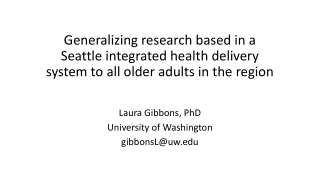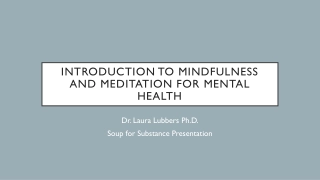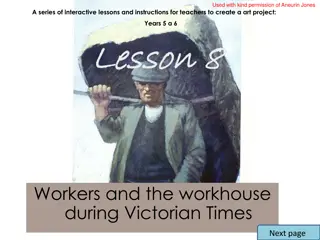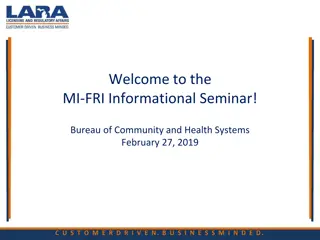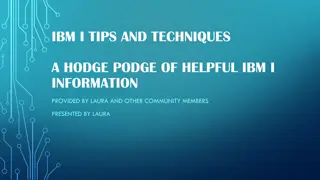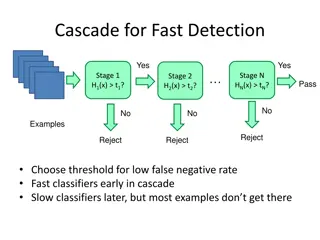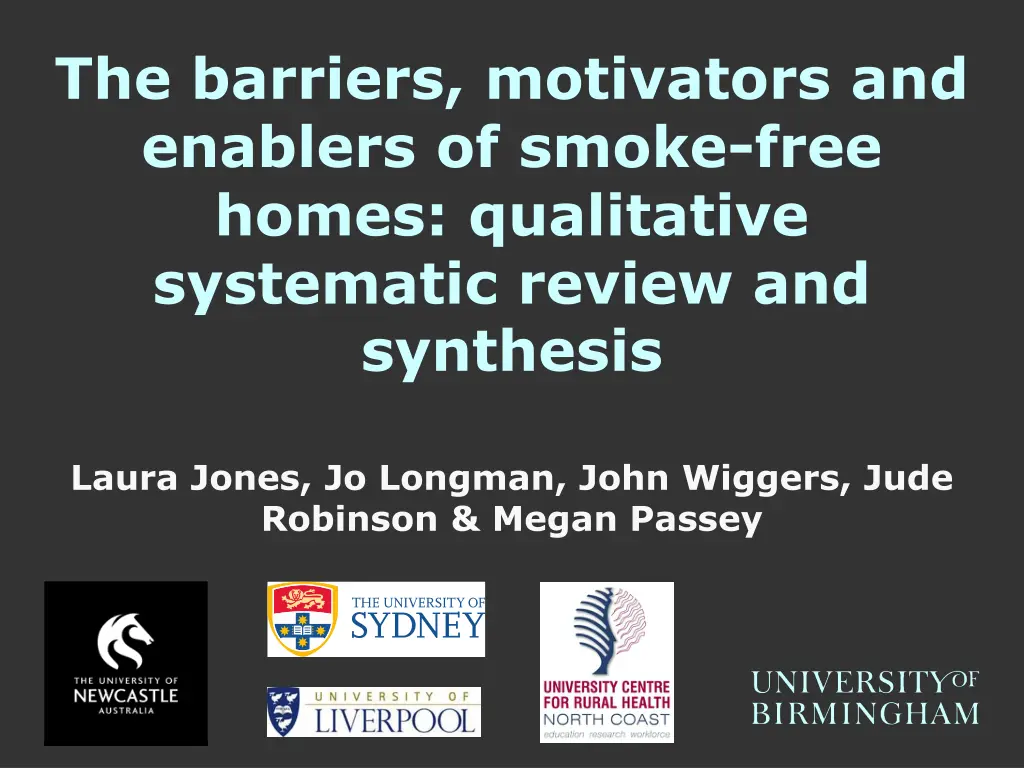
Understanding Smoke-Free Homes: Barriers, Motivators, and Enablers Synthesis
Discover the barriers, motivators, and enablers influencing smoke-free homes through a systematic review. Explore the global impact of secondhand smoke exposure, intervention evidence, and qualitative findings. Uncover the insights on promoting caregiver quitting and fostering smoke-free environments based on research questions and methodologies.
Download Presentation

Please find below an Image/Link to download the presentation.
The content on the website is provided AS IS for your information and personal use only. It may not be sold, licensed, or shared on other websites without obtaining consent from the author. If you encounter any issues during the download, it is possible that the publisher has removed the file from their server.
You are allowed to download the files provided on this website for personal or commercial use, subject to the condition that they are used lawfully. All files are the property of their respective owners.
The content on the website is provided AS IS for your information and personal use only. It may not be sold, licensed, or shared on other websites without obtaining consent from the author.
E N D
Presentation Transcript
The barriers, motivators and enablers of smoke-free homes: qualitative systematic review and synthesis Laura Jones, Jo Longman, John Wiggers, Jude Robinson & Megan Passey
Global SHS exposure 40% of children, 33% non-smoking males and 35% of non-smoking females 600 000 annual deaths: 28% children, 26% men and 47% women Countries with SFL exposure in homes and cars Countries without SFL exposure in homes and workplaces Oberg et al. 2011
SHS intervention evidence Child focussed Mixed evidence for effectiveness of SHS/SFH interventions Need for more research
SHS qualitative evidence Promote caregiver quitting Promote smoke-free homes Some caregivers are successful, others find it very difficult Qualitative evidence base exploring caregivers home smoking behaviours and experiences yet to be synthesised Jones et al. 2011; Robinson et al. 2010, 2009. 2007a, 2007b; Phillips et al. 2007, Blackburn et al. 2003
Review questions (1) What are the barriers to, enablers and motivators of initiating and maintaining a smoke-free home? (2) Do the barriers, enablers and motivators to creating smoke-free homes differ by context? PROSPERO protocol registration: CRD42014014115
Methods: search & extraction Systematic search for relevant qualitative and mixed-methods peer reviewed publications in English (1990-2014) Study data extracted via proforma Data managed using NVivo Critical appraisal using modified CASP
Methods: thematic synthesis Line by line coding; comparing & grouping of codes; descriptive themes; analytical themes (Thomas & Harden 2008) Eight papers (36%) independently coded Final codebook applied across all papers Descriptive and analytic themes (ongoing) developed within team
Results: included papers Phillips 2007; Ritchie 2009; Robinson 2011; Wilson 2013; Scotland Bottorff 2010; British Columbia Canada Coxhead 2006; Holdsworth 2008; Robinson 2007, 2008, 2009; Jones 2011; England Herbert 2011; PEI Canada Poland 2009; Toronto Canada Mao 2013; Mainland China Yousey 2007; Colorado USA Kegler 2007, Escoffery 2009; Georgia USA Abdullah 2012; Jiangsu China 22 studies from 18 datasets (2 studies extended original dataset) 4 Australia; 3 Canada; 2 China; 10 UK; 3 USA 646 participants: 633 caregivers & 13 HCPs 58 FGs; 474 interviews; 2 expert panels; observations 14 high quality; 8 low quality Jochelson 2003, Gould 2013; NSW Australia Roberts 2000; South Australia Hill 2003; Victoria Australia
Results: theme summary BARRIERS ENABLERS MOTIVATORS Influence of others Agency SHS awareness & health protection Knowledge & perception of SHS risk & risk reduction Being a good parent Practicalities Practicalities & strategies Perceived benefits of smoking Benefits of having a SFH Desire to live in a clean, odour free and safe environment Personal attributes Lifestyle choice Social norms around SHS Priorities Addiction/habit Household changes
Barriers Indoor smoking by others was often not challenged because of the need or desire to preserve social and relational bonds with the smoker (Bottorff 2001, Mao 2013, Jones 2011, Robinson 2008, Yousey 2007). Influence of others Exposure to SHS was recognised as being harmful; however, the specific risks and the continuing risks as the child aged (Abdullah 2012, Jochelson 2003, Jones 2011, Kegler 2007, Mao 2013, Robinson 2007 & 2009) were often not appreciated or acknowledged. Knowledge & perception of SHS risk & risk reduction I try to avoid smoking at home, but sometimes I really cannot help myself and start smoking in front of my child. I really need some help (Abdullah 2012) Addiction/habit
Enablers Smoking household members and visitors acceptance of and compliance with household smoking rules was facilitated by the normality and assumed nature of protecting others from SHS, particularly children (Bottorff 2001, Escoffery 2009, Holdsworth 2008, Kegler, Robinson 2009 & 2011, Poland 2009) Influence of others If I don t want people to smoke around my kids I tell them. It s my house and my kids (Coxhead 2006) Agency It s not something that s even discussed anymore, it s just automatically assumed that you don t smoke in the house (Poland 2009) Social norms around SHS
Motivators Caregivers were aware (Holdsworth 2008) and mindful (Robinson 2011) of the dangers of exposing others, in particular children, to SHS. SHS awareness & health protection Homes which showed signs of smoke exposure (e.g. nicotine stains) and which smelled of smoke were perceived as socially unacceptable (Robinson 2011) and associated with stigma (Holdsworth 2008) Desire to live in a clean, odour free & safe environment It makes me smoke less having to go outside [I] tend not to go out as much and smoke (Escoffery 2009) Benefits of having a SFH
Evidence base limitations Cross-sectional Retrospective Hypothetical rather than experiential Authors are not explicit about participants home smoking rules Focussed on reducing children s SHS rather than SFH
Current evidence gaps Home smoking rules during pregnancy & early post natal period The male voice Other adults (vulnerable/sick) Learning from successful smoke-free households Other countries, in particular, those with high tobacco consumption
Implications for policy & practice Power of social norms Clarity & consistency of SHS risk messages Complete ban (where achievable) SF households rather than individuals Strengths based approach harnessing motivation
Funding National Health and Medical Research Council of Australia Early Career Fellowship (APP1072213) Cancer Institute New South Wales Early Career Fellowship (13/ECF/1-11) Wellcome Trust and University of Birmingham ISSF Mobility Scholarship L.L.Jones@bham.ac.uk 0121 414 3024
Presentation References Baxi R, Sharma M, Roseby R, Polnay A, Priest N, Waters E et al. Family and carer smoking control programmes for reducing children's exposure to environmental tobacco smoke. Cochrane Database Syst Rev. 2014;3:CD001746. Baxter S, Blank L, Everson-Hock ES, Burrows J, Messina J, Guillaume L, et al. The effectiveness of interventions to establish smoke-free homes in pregnancy and in the neonatal period: a systematic review. Health Educ Res. 2011;26(2):265-82. Blackburn C, Spencer N, Bonas S, Coe C, Dolan A, & Moy R. Effect of strategies to reduce exposure of infants to environmental tobacco smoke in the home: Cross sectional survey. BMJ, 2003;327:257. Thomas J & Harden A. Methods for the thematic synthesis of qualitative research in systematic reviews. BMC Med Res Methodol. 2008;10(8):45. Jones LL, Atkinson O, Longman J, Coleman T, McNeill A, Lewis SA. The motivators and barriers to a smoke-free home among disadvantaged caregivers: identifying the positive levers for change. Nicotine & tobacco research . 2011;13(6):479-86. Oberg M, Jaakkola MS, Woodward A, Peruga A, Pruss-Ustun A. Worldwide burden of disease from exposure to second-hand smoke: a retrospective analysis of data from 192 countries. Lancet. 2011;377(9760):139-46
Presentation References Phillips R, Amos A, Ritchie D, Cunningham-Burley S, Martin C. Smoking in the home after the smoke-free legislation in Scotland: qualitative study. BMJ. 2007;335(7619):553-7. Robinson J & Kirkcaldy AJ. Disadvantaged mothers, young children and smoking in the home: Mothers use of space within their homes. Health and Place. 2007a;13:894 903. Robinson J & Kirkcaldy AJ. You think that I m smoking and they re not : Why mothers still smoke in the home. Social Science and Medicine, 2007b;65:641 652. Robinson J, Kirkcaldy AJ. 'Imagine all that smoke in their lungs': parents' perceptions of young children's tolerance of tobacco smoke. Health Educ Res. 2009 Feb;24(1):11- 21. Robinson J, Ritchie D, Amos A, Cunningham-Burley S, Greaves L, Martin C. Waiting until they got home : Gender, smoking and tobacco exposure in households in Scotland. Soc Sci Med. 2010;71(5):884-90. Rosen LJ, Myers V, Hovell M, Zucker D, Ben Noach M. Meta-analysis of parental protection of children from tobacco smoke exposure. Pediatrics. 2014;133(4):698- 714.
Review References Abdullah AS, Hua F, Xia X, Hurlburt S, Ng P, MacLeod W, Siegel M, Griffiths S, Zhang ZY: Second-hand smoke exposure and household smoking bans in Chinese families: a qualitative study. Health & Social Care in the Community 2012, 20(4):356-364. Bottorff JL, Johnson JL, Carey J, Hutchinson P, Sullivan D, Mowatt R, Wardman D: A family affair: Aboriginal women's efforts to limit second-hand smoke exposure at home. Canadian Journal of Public Health 2010, 101(1):32-35. Coxhead L & Rhodes T. Accounting for risk and responsibility associated with smoking among mothers of children with respiratory illness. Sociology of Health and Illness, 2008, 28(1): 98 121. Escoffery C, Kegler MC, Butler S: Formative research on creating smoke-free homes in rural communities. Health Education Research 2009, 24(1):76-86. Gould GS, Munn J, Avuri S, Hoff S, Cadet-James Y, McEwen A, Clough AR: "Nobody smokes in the house if there's a new baby in it": Aboriginal perspectives on tobacco smoking in pregnancy and in the household in regional NSW Australia. Women and Birth 2013, 26(4):246-253. Holdsworth C & Robinson JE. "I've never ever let anyone hold the kids while they've got ciggies : moral tales of maternal smoking practices. Sociology of Health & Illness 2008, 30(7): 1086-1100. Please note that only the first author was cited in the slides
Review References Jochelson T, Hua M et al. Knowledge, attitudes and behaviours of caregivers regarding children's exposure to environmental tobacco smoke among Arabic and Vietnamese-speaking communities in Sydney, Australia. Ethnicity & Health. 2003, 8(4): 339-351 Jones LL, Atkinson O, Longman J, Coleman T, McNeill A, Lewis SA. The motivators and barriers to a smoke-free home among disadvantaged caregivers: identifying the positive levers for change. Nicotine & tobacco research . 2011;13(6):479-86. Kegler,M & Escoffery M. A qualitative study of how families decide to adopt household smoking restrictions. Family & Community Health, 2007, 30(4): 328-341. Mao A. Space and power: Young mothers' management of smoking in extended families in China. Health & Place. 2013, 21: 102-109. Poland, B., D. Gastaldo, et al. (2009). "The interpersonal management of environmental tobacco smoke in the home - a qualitative study." Critical Public Health. 2009, 19(2): 203-221. Robinson J. Trying my hardest : The hidden social costs of protecting children from environmental tobacco smoke. International Review of Qualitative Research. 2008, 1, 173 194. Please note that only the first author was cited in the slides
Review References Robinson J & Kirkcaldy A. Disadvantaged mothers, young children and smoking in the home: Mothers' use of space within their homes. Health & Place. 2007, 13(4): 894- 903. Robinson J & Kirkcaldy A "Imagine all that smoke in their lungs : parents' perceptions of young children's tolerance of tobacco smoke. Health Education Research. 2009, 24(1): 11-21. Robinson J, Ritchie D, et al. Volunteered, negotiated, enforced: family politics and the regulation of home smoking. Sociology of Health & Illness. 2011, 33(1): 66-80. Yousey, Y. "Family attitudes about tobacco smoke exposure of young children at home. American Journal of Maternal-Child Nursing. 2007, 32(3): 178-183. Please note that only the first author was cited in the slides

